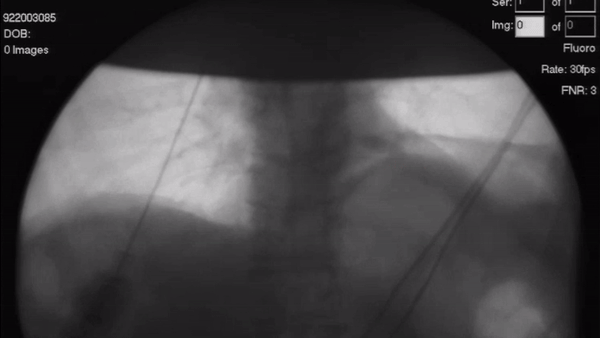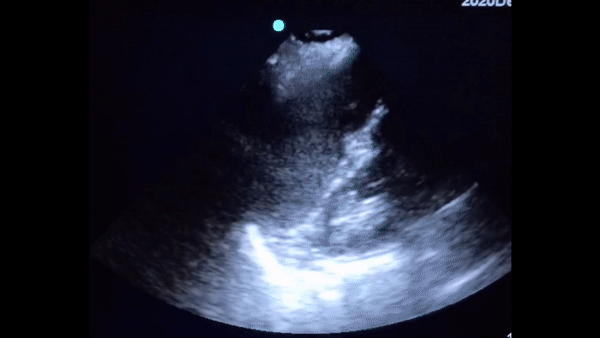The Weakness Link
Richard H. Zou, MD 1, Stephanie I. Maximous, MD, MS 1
1 Division of Pulmonary, Allergy, and Critical Care Medicine, Department of Medicine, University of Pittsburgh Medical Center, Pittsburgh, PA
Case
A 69-year-old woman with a history of cervical stenosis with recent anterior cervical discectomy and fusion and lumbar radiculopathy with foot drop presented with one year of generalized fatigue, lower extremity weakness, frequent falls, and unintentional 40 lb weight loss. These symptoms were accompanied by progressive exertional dyspnea; outpatient spirometry was notable for FEV1/FVC 0.87, FEV1 1.20 L (72% predicted), and FVC 1.38 L (62% predicted); no lung volumes were performed. The patient was admitted for failure to thrive. Physical examination was remarkable for tongue fasciculations, hyperactive jaw jerk, hand muscle atrophy, positive Hoffman’s sign, and preserved lower extremity strength. Her hospital course was complicated by nocturnal hypoxia requiring 3 L/min oxygen. Arterial blood gas, on room air, was notable for pH 7.34, pCO2 72 mmHg, pO2 49 mmHg, and HCO3 37 mEq/L. Review of prior chest radiography revealed persistently elevated left hemidiaphragm. The following test was subsequently performed:

Image 1
Question
What is the most likely etiology of the patient’s mixed hypoxemic/hypercapnic respiratory failure?
- Amyotrophic lateral sclerosis
- Multiple sclerosis
- Spinal stenosis
- Iatrogenic phrenic nerve injury
- Chest wall disorder
A. Amyotrophic lateral sclerosis
Discussion
The patient’s fluoroscopic sniff test, also known as diaphragm fluoroscopy, demonstrated minimal bilateral diaphragmatic excursion during inspiration. Electromyogram revealed widespread motor axonal loss affecting lower cranial, cervical, thoracic, and lumbar segments. She was diagnosed with advanced amyotrophic lateral sclerosis (ALS).
ALS, commonly referred to as Lou Gehrig’s disease, is a progressive and incurable neurodegenerative disorder affecting both upper and lower motor neurons [1]. Clinically, upper motor neuron signs manifest as dysarthria, dysphagia, increased muscle tone, spasticity, hyperreflexia, and pathologic reflexes, such as positive Hoffman’s and Babinski signs. Clinically, lower motor neuron signs manifest as muscle weakness, fasciculation, muscle atrophy, and flaccidity. Electrodiagnostic studies are essential in the evaluation process and can rule out other disease entities. The overall treatment is focused on symptom-based management. Non-invasive positive pressure ventilation remains standard of care and has been associated with improved quality of life and survival in this population [2,3]. Ultimately, invasive mechanical ventilation may be necessary due to disease progression. Frequent discussions are necessary to ascertain patient goals and values.
In this patient, there was initial concern that her recent anterior cervical discectomy and fusion ( answer D) may have contributed to phrenic nerve damage with resultant loss of diaphragmatic excursion. However, her motor neuron signs and progressive dyspnea with restrictive lung physiology preceded her surgery. Multiple sclerosis ( answer B) is not classically associated with electromyogram abnormalities. Spinal stenosis ( answer C) may cause neurogenic claudication, motor neuron lesions, and diaphragmatic dysfunction but would not explain her tongue fasciculations or hyperactive jaw reflex. Chest wall disorders ( answer E) may contribute to restrictive lung physiology but should not have motor neuron lesions.
Prior to her fluoroscopic sniff test, bedside ultrasonography demonstrated minimal excursion of the left hemidiaphragm and weak excursion of the right hemidiaphragm. Ultimately, the patient was started on nocturnal non-invasive positive pressure ventilation and underwent percutaneous endoscopic gastrostomy placement for nutritional support.

Image 2
References
-
Rowland LP. Diagnosis of amyotrophic lateral sclerosis. J Neurol Sci. 1998;160(1):S6.
-
Andersen PM, Abrahams S, Borasio GD, et al. EFNS guidelines on the clinical management of amyotrophic lateral sclerosis (MALS) – revised report of an EFNS task force. Eur J Neurol. 2012;19(3):360-375.
-
Radunovic A, Annane D, Rafiq MK, et al. Mechanical ventilation for amyotrophic lateral sclerosis/motor neuron disease. Cochrane Database Syst Rev. 2017;10(10):CD004427.



